Unexpected Fruits To Upgrade Your Upside-Down Cake
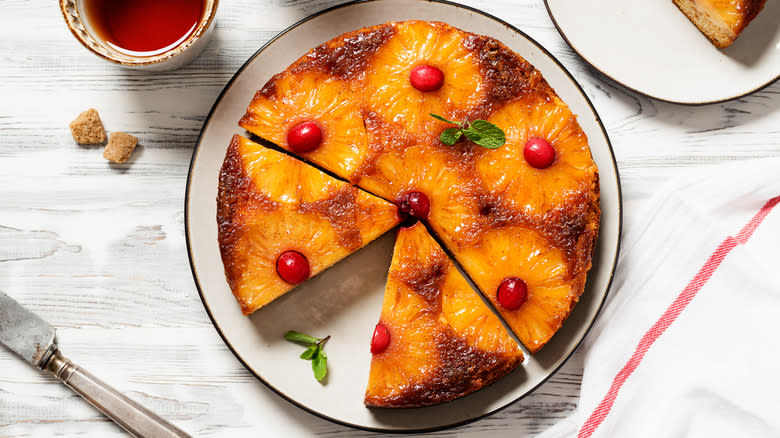
When people think of "upside-down cake," the first fruit that comes to mind is pineapple. Pineapple upside-down cake has been the premier upside-down cake in the United States since around the 1920s. In 1925, canned fruit company Dole held a contest to see who could come up with the best pineapple-based recipe to make use of the company's canned pineapple. A recipe for pineapple upside-down cake was ultimately the winner, and the rest is history.
But there are so many other kinds of fruit out there. Pineapple should not be allowed to gatekeep the upside-down cake sector. Before its ascent to the cake throne, plenty of other fruits were used to create delicious cakes that presented eaters with glorious caramelized fruit when flipped upside-down. With so many fruit possibilities, we decided to take this opportunity to highlight some of the most surprising fruits that you could be using to make a delicious upside-down cake for your next party.
Read more: 7 Nuts You Should Be Eating And 7 You Shouldn't
Pawpaw
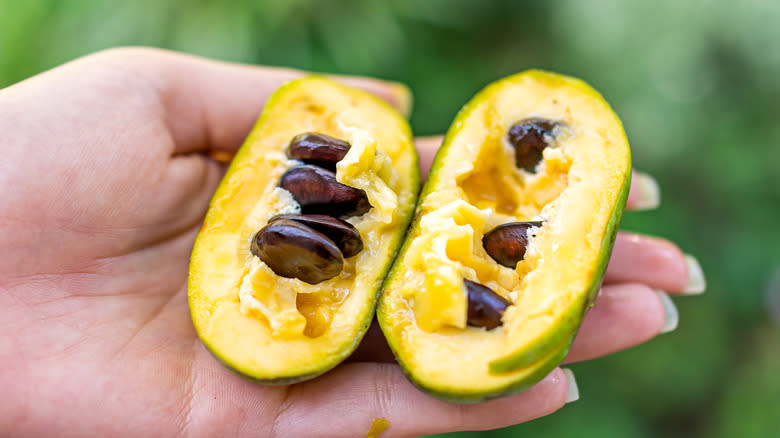
The pawpaw as a fruit has generally flown under the radar, which is sad because it is delicious. The pawpaw is native to the United States, so we think it is time the pineapple moves over and makes room in the American diet for pawpaw upside-down cake.
Pawpaws offer a texture similar to bananas. They have tough exterior skin but a smooth and creamy inside. Another name for this fruit is "American custard apple," named for its velvety fruity center. Another similarity to the banana is the flavor, which offers tropical notes that can vary from variety to variety but can include flavors of banana, mango, and even pineapple.
With its smooth texture and bright flavor, the pawpaw makes an excellent choice for a unique upside-down cake — once the fruit has been peeled and seeded, that is. Pawpaws lend themselves to additional warm spices, making their flavor profile customizable.
Papaya
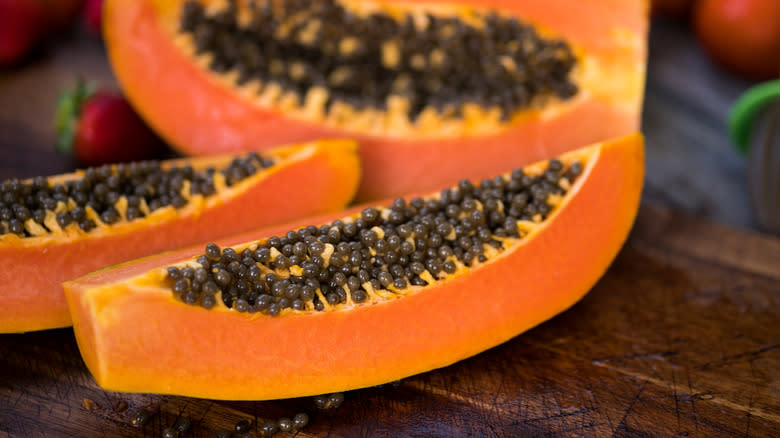
This next fruit, confusingly enough, can also go by the name "pawpaw" but is more commonly known as "papaya." The papaya and the American pawpaw are two completely different fruits that are not related. However, they have one thing in common: they make an excellent, surprising choice for an upside-down cake.
The papaya is an oblong fruit with bright orange flesh and tiny black seeds. Papaya is naturally sweet and is often compared to cantaloupe in terms of flavor. This mellow yet fruity flavor lends itself to upside-down cake, especially when paired with something like a nut to add some additional texture. While the seeds are edible, eating too many can have unintended consequences. Pairing papaya with dried fruit or some nuts for an upside-down cake will re-introduce the texture you may otherwise be missing.
Papayas are known for having a host of health benefits, such as being packed with antioxidants and beta-carotene, which is where its bright orange color comes from (via Medical News Today). With so many benefits, it is worth a try in some cake.
Persimmon
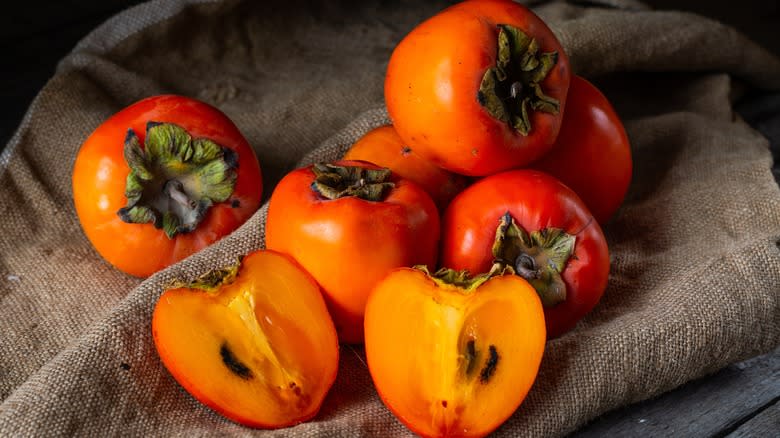
At first glance, you may think this fruit is a tomato but do not be alarmed. It is actually a delightful fruit known as persimmon. Persimmons are an orange-colored fruit that, when ripe, taste similar to an apricot. When not fully ripe, though, they can be acidic and unpleasant.
Persimmons are finally becoming more common after years of being more of a specialty item. There are two main varieties of persimmon: the Japanese persimmon and the American persimmon. Ironically enough, the Japanese persimmon is more common in grocery stores. That being said, each variety has its own benefits.
Just to make things a little more confusing, there are two classifications for persimmons. Non-astringent persimmons tend to be much sweeter and can be eaten at varying stages of ripeness. On the other hand, astringent persimmons have to be fully ripe and soft to be edible.
Persimmons make a wonderful option for those experimenting with upside-down cakes. Picking a less sweet variety can make for a beautiful complexity, whereas choosing a sweet one can make a stunning treat. Either way, the persimmon deserves a chance on your plate.
Tomato
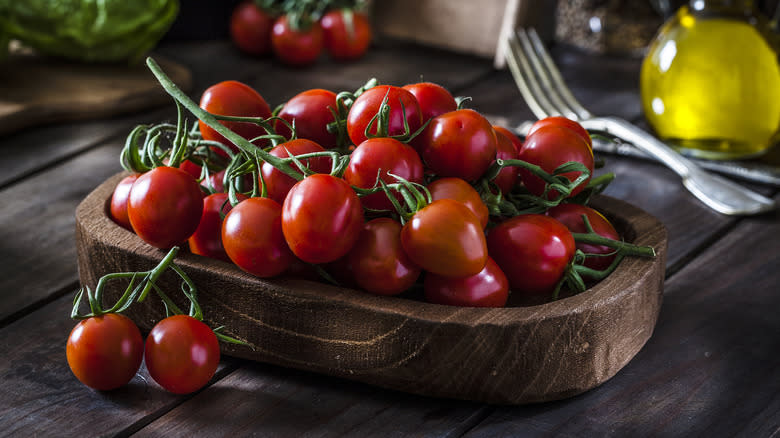
If you were feeling relieved after the last post, we are sorry to inform you that the fruit is indeed a tomato this time. While the tomato is a fruit, it is commonly used in cooking as a vegetable. Still, we would argue that upside-down cake gives the tomato a chance at the fruity redemption arc it so desperately deserves.
This may come as a surprise to people, but tomatoes have actually been an unexpected ingredient in cakes prior to this. Recipes for old-school Campbell's tomato soup cake can be found all over the internet. To further highlight tomatoes' sweet attributes, some Redditors point out that it is not unheard of for people to eat tomatoes with cream and sugar. Don't knock it till you try it.
As a fruit, tomatoes can be surprisingly sweet, but they also add an acidic bite. In Campbell's tomato soup cake recipes, there are often a lot of spices, which translates well to an upside-down cake.
Of course, no one says a tomato cake must be sweet. While sweet upside-down cake is more traditional, nothing is stopping upside-down cake from being savory. In fact, savory cakes seem to be having a moment. So why not try a savory version, perhaps with herbs like basil or oregano, and surprise your guests?
Cherries
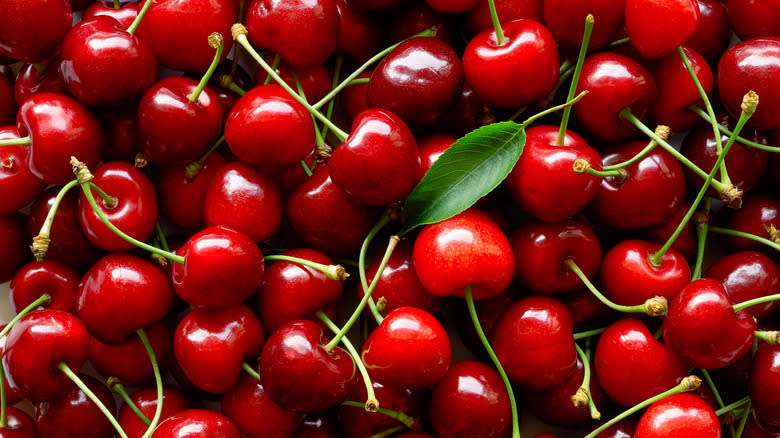
Maraschino cherries are already a part of the classic pineapple upside-down cake but are more of a sugary afterthought. We think it is time this tart pitted fruit took over as the star of the show.
When we say cherries, we do not refer to artificially reddened and sweetened maraschino cherries but to whole fresh ones. There are a variety of cherries that are available starting as early as May and through the summer. Each type brings with it unique characteristics. Black cherries, for example, are dark and sweeter than other varieties. Amarena cherries are also dark but quite sour, and Bing cherries are bright red and sweet.
Using cherries as the base of your upside-down cake gives you the freedom to play with tart acidic flavors while bringing a pop of color to your cake. Cherry upside-down cake may not be the most popular kind of upside-down cake, but we are sure that once you give it a try, you will never look back.
Ground Cherry (Husk Cherry)
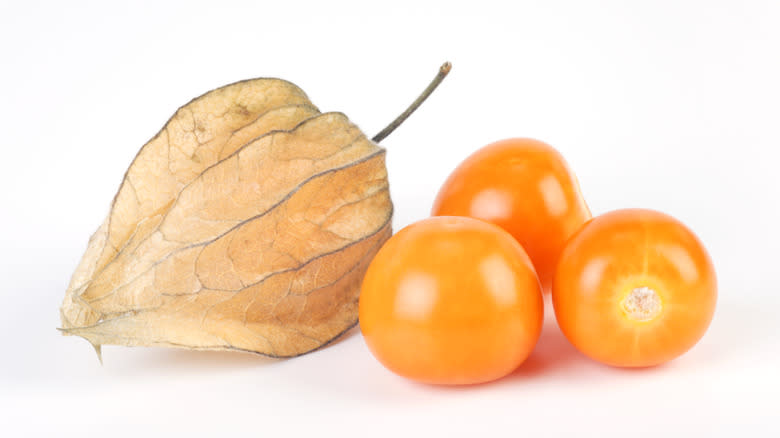
Ground cherries, also known as golden cherries or husk cherries, are small fruits native to the Americas. The fruits can be red, orange, or yellow. They are distinguished by the papery husk that surrounds them. When the fruit is ripe, the husk becomes dry. If this sounds similar to another fruit, it is because they are also related to tomatillos, which look similar but are larger and offer a tarter flavor. Technically speaking, "ground cherry" is a term that encapsulates the whole Physalis species, which includes tomatillos. But common usage of the term refers to the smaller, sweeter variety. This is the type we are referring to.
Part of the reason ground cherries make a surprisingly good upside-down cake is the flavor often has notes of other fruits, such as the tried and true pineapple. Some people also describe the taste as similar to a grape or a cantaloupe.
Once again, this is a fruit that will offer a bright punch of color to any upside-down cake. Just make sure to remove the husks before baking.
Lychee
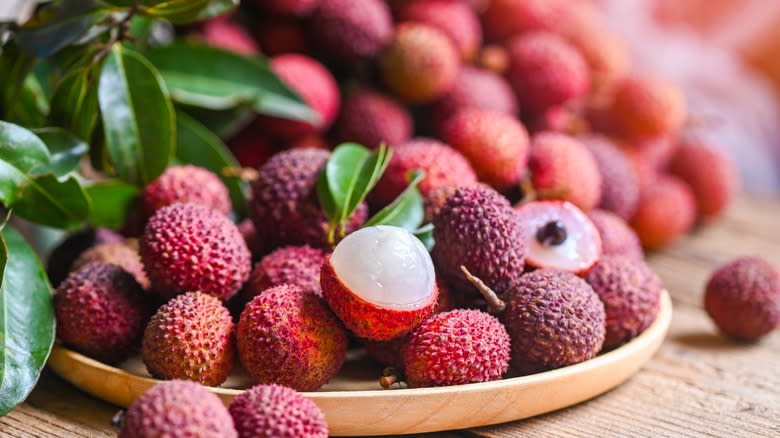
While lychee is not super well-known here in the United States, it is a popular choice for desserts in Asia, where it originated. The fruit is lightly flavored and sweet with floral notes.
The exterior of a fresh lychee is rough and pink, with small spines. This and the interior seed must be removed before using the fruit in an upside-down cake. The flesh of the fruit is a pale, creamy white. While lychee can be purchased fresh, it is often easier and more common to find lychee canned in syrup and all ready to go. The nice thing about this is that it will take some of the guessing out of the equation for those who have not cooked with lychee before.
Canned lychee is often used to make ice creams, cakes, and other desserts, so it is a natural progression to use lychee to make an upside-down cake.
Rhubarb
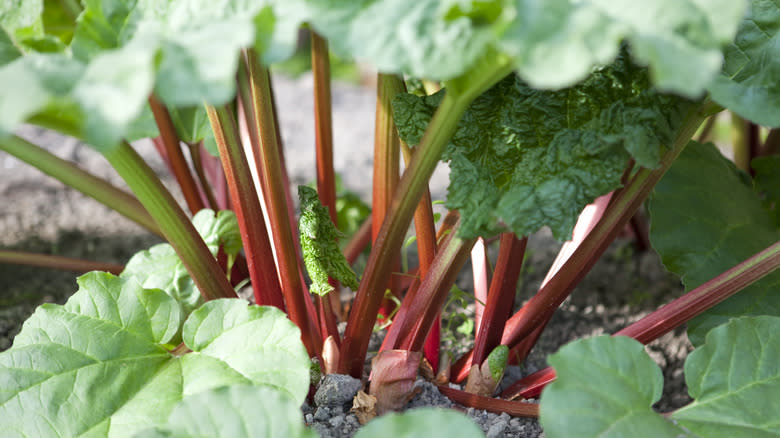
Okay, we know rhubarb is not scientifically classified as a fruit. Rhubarb is actually a vegetable, but we would argue that rhubarb is used like a fruit when it comes to cooking.
Rhubarb has thick red stocks and big, bushy green leaves. It is the stock of rhubarb that is used for cooking. Rhubarb has a distinct, tart flavor. Often, it gets paired with fruits, such as strawberries, in baked goods like strawberry rhubarb pie. However, it does not have to be paired with another fruit to make a delicious dessert.
In an upside-down cake, tangy rhubarb can provide a brilliant contrast to the sugary cake and syrup. This combination can be left as is, or yes, paired with an additional sweet fruit to really bump up the flavors. Whatever you decide, rhubarb will make a unique and surprising addition to any cake and is sure to hold up beautifully, especially when paired with ice cream.
Orange
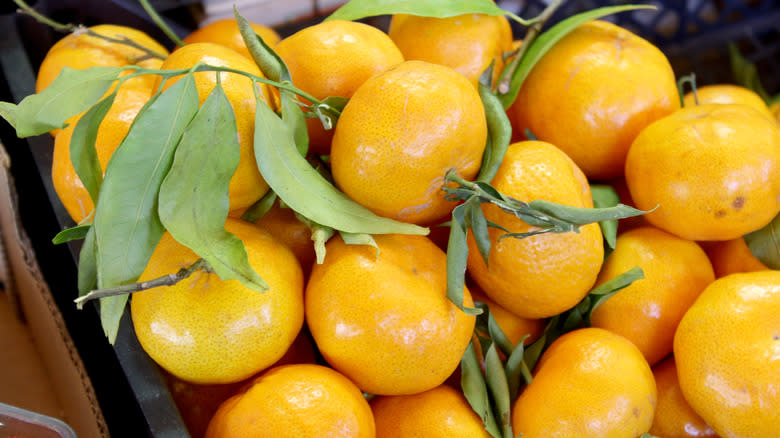
Citrus is a wonderful fruit to use in desserts as it is bright, sweet, and tart all at the same time. Oranges make a wonderful addition to upside-down cake, especially with all the varieties there are to choose from.
Oranges have been cultivated for thousands of years, especially in China, where they are from. There are small, sweet mandarin oranges, deeply colored and flavored blood oranges, and many others. Picking just one to start with can be difficult. So why choose one? Use a variety. Just make sure they are peeled and any seeds are removed before putting them in your cake.
For those looking to take a bit of a shortcut, try breaking out a can of mandarin oranges. These can be a great time saver, as the mandarins are already peeled and separated into segments.
Around the holidays, pairing oranges with flavors such as tart cranberries can bring a festive melding of flavors.
Lemon
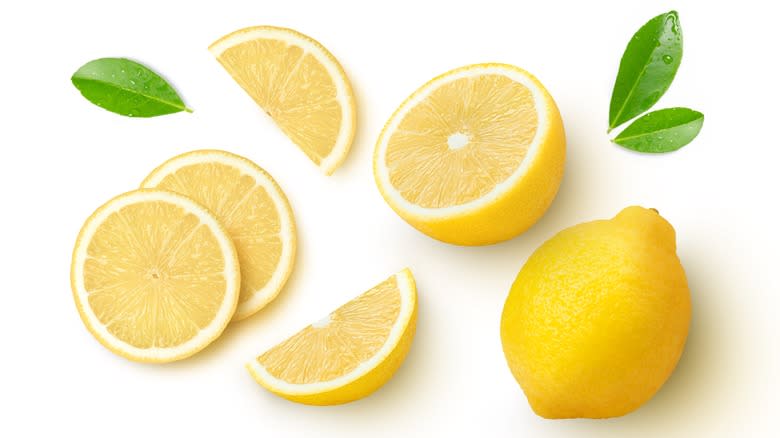
Lemon is a popular flavor for desserts. Lemon bars, lemon cakes, and lemon pies are all fairly standard fare. However, usually, these desserts use juice or some zest. But for an upside-down cake, you need slices of the whole fruit.
This may strike some as an odd way to use a lemon, but it is hardly the first time a whole lemon has been incorporated into a dessert. Let's remember the episode of the "Great British Baking Show" where contestants had to make a Sussex Pond pudding, which was literally a boiled baked good with an entire lemon in it. It left some scratching their heads as they tried to figure out the recipe.
Rest assured, we do not suggest sticking a whole lemon in your cake. Instead, we recommend slicing lemons thin and using them as a base to create a tart layer. Since upside-down cake usually consists of a boiled sugar syrup with the fruit, there will be plenty of sweetness to offset the sour pieces of lemon and leave your diners with a delightful dessert.
Kiwi
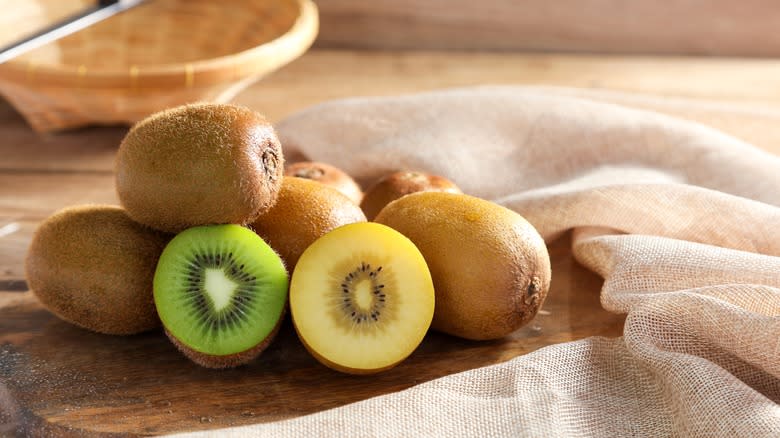
Kiwis are often assumed to be from New Zealand, but the fruit is actually imported from China. The original English name it was given when the fruit first started to appear on the market was Chinese gooseberry because it tasted similar to gooseberries. Crucially, though, kiwis are not related to gooseberries.
Despite several name changes, it is now hard to remember a time without these small, fuzzy, green fruits. This is why we think it is time they made an appearance in your next upside-down cake.
There are, unsurprisingly, many varieties of kiwi that produce different colors and flavors, as well as fuzz levels. Kiwis are sweet, with just a hint of a tangy bite to them. They offer a tropical flavor and the tiny black seeds give just a hint of a crunch. There is no need to remove the seeds from kiwis before baking, though you may want to remove the skin. While technically edible, the fuzzy skin may not give you the texture you are going for.
Banana
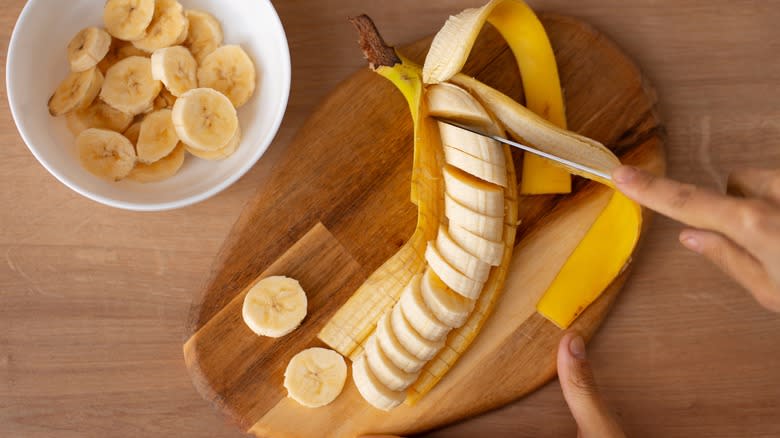
It is time to break out of your banana bread rut and put your over-ripe bananas to new use. Bananas are a natural pairing for cake. The texture, even before baking, is soft and creamy. They hold a delicious sweetness, which just gets stronger as they ripen, and a mellow flavor. The fruit has been around for thousands of years, and while the most common baked good people make with it is banana bread, we argue that instead of mushing the bananas up, it is time to slice them and use them in an upside-down cake.
Upside-down banana cake is like a combination of upside-down cake and a bananas Foster dessert. Like upside-down cake, bananas Foster stars a caramelized brown sugar syrup base and sliced fruit. Sure, bananas Foster typically also includes rum, but there is nothing stopping you from throwing some of that into your banana upside-down cake as well. We are sure it would be delicious.
Pear
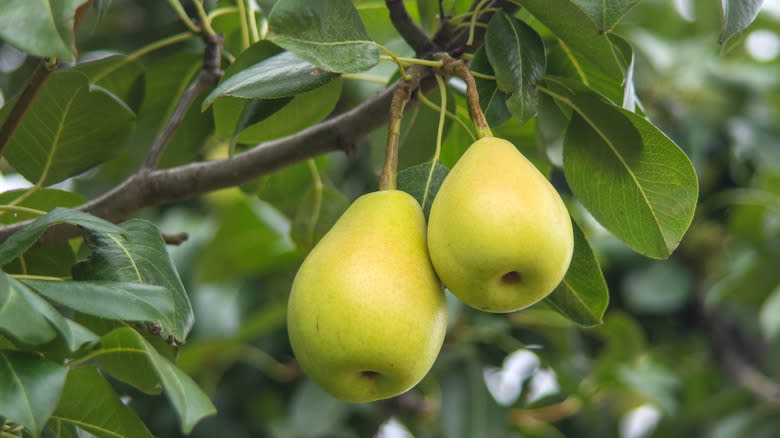
As upside-down desserts go, tarte tatin is practically a cousin to the upside-down cake. Where tarte tatin uses puff pastry, upside-down cake uses cake batter. It makes sense that you could shift away from the traditional apple topping to another, similar fruit to create a whole new upside-down cake experience. In this case, we are talking about pears.
Pears are similar to apples in taste and texture but are uniquely their own. It is unsurprising that these two fruits are related, but that is exactly why pears work so well for an upside-down cake.
As pears cook, they become soft and a little sweet. The consistency, when baked, can become almost buttery. Like apples, there is a seemingly never-ending variety of pears. Do your research to find the taste profile you like the best. Common varieties such as Anjou, Bosc, and Bartlett are good places to start. The fruit pairs beautifully with spices and vanilla, but if you want a relatively unadulterated pairing, a simple caramel with pear will highlight the fruit's natural flavor and give an elegant, delicious finish.
Apricot
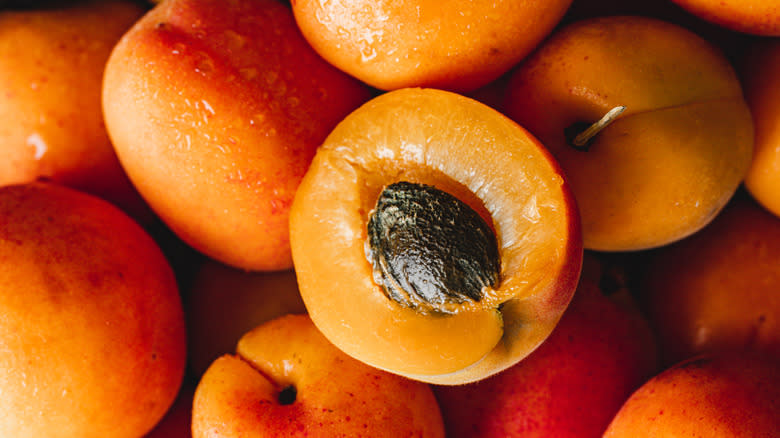
The apricot is a fruit with a lot of personality. Its flavor is almost like a peach, but apricots pack more of a punch and are noticeably more acidic than peaches, with a savory edge. They are also significantly smaller than peaches. Like peaches, apricots are stone fruits.
While it is expected to see apricots in baking as either chopped dried pieces or as a jam, using fresh sliced apricots can elevate your upside-down cake to new levels. Once again, we see that play of tart and sweet. This is the very thing that has helped make pineapple upside-down cake so popular over the years.
Use apricots upside down in a brown sugar sauce, and consider pairing them with slivered almonds or topping them with whipped cream to bring some additional creamy notes to the fruit. The top will end up intensely orange and juicy without being sopping wet and soggy, as apricots have a lower moisture content than other stone fruits.
Peach
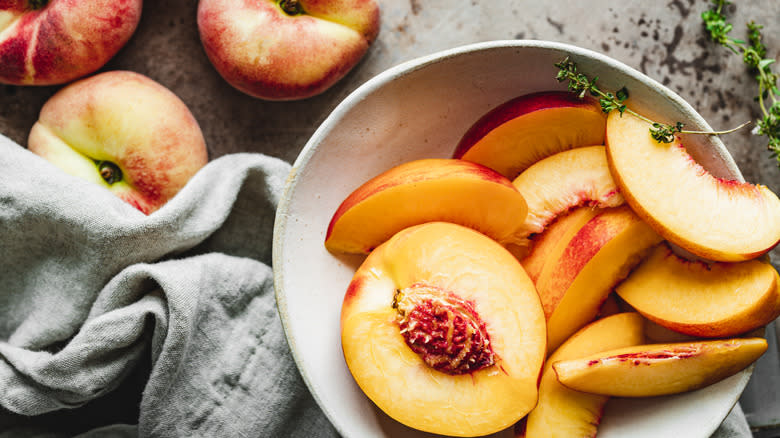
Finally, while apricots are peachy, sometimes you just need to go straight to the source and use a peach. Peaches are brightly flavored, sweet, and juicy. Obviously, they are fantastic eaten plain, but when paired with a dessert, peaches can be taken to whole new levels.
Peaches are a stone fruit, which means the pits will have to be removed before being used in a cake. Because of this, we recommend getting what are known as freestone peaches, which refers to peaches where the pit is not attached to the rest of the peach and can be removed easily. We also recommend using yellow peaches for baking, as they hold their form better. This is especially important for upside-down cakes.
As an added bonus, you do not have to peel peaches before baking them. While peaches have velvety skin, as the peach cooks, the skin gets softer and will not be as noticeable as it is when fresh. That being said, if you want to avoid any additional texture, feel free to peel them.
Read the original article on Mashed.

